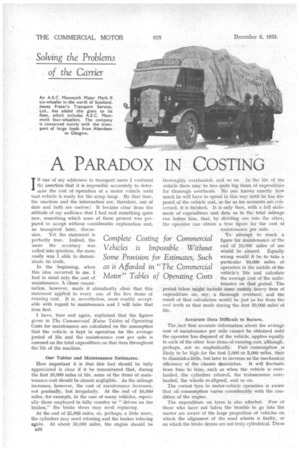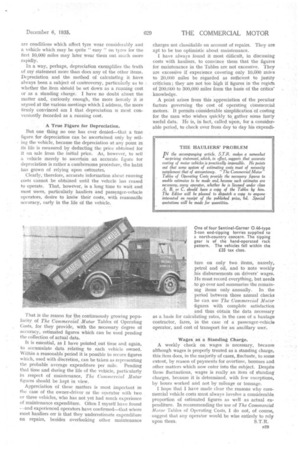A PARADOX IN COSTING I N one of my addresses to
Page 42

Page 43

If you've noticed an error in this article please click here to report it so we can fix it.
transport users I ventured tha assertion that it is impossible accurately to determine the cost of operation of a motor vehicle until that vehicle is ready for the scrap heap. By that time, the machine and the information are therefore, out of date and both are useless ? It became clear from the .attitude of my audience that I had said something quite new, something which none of those present was prepared to accept without considerable explanation and, as transpired later, discussion. Yet the statement is perfectly true. Indeed, the more the accuracy was called into question, the more easily was I able to demonstrate its truth.
In the beginning, when this idea. occurred to me, I had in mind only. the cost of maintenance. A closer examination, however, made it abundantly clear that this statement applied to every one of the five items of running cost. It is, nevertheless, most .readily acceptable with regard to maintenance and I will take that item first.
I have, time and again, explained that the figures given in The Comme rcial Motor Tables of Operating Costs for maintenance are calculated on the assumption that the vehicle is kept in operation for the average period of life and the maintenance cost per mile is assessed on the total expenditure on that item throughout the life of the machine.
Our Tables and Maintenance Estimates.
How important it is that this fact should be fully appreciated is clear if it be remembered that, during the first 10,000 miles of life, some of the items of maintenance cost should be almost negligible. As the mileage increases, however, the cost of maintenance increases, not gradually, but irregularly. At the end of 10,000 miles, for example, in the ease of many vehicles, especially those employed in hilly country or "driven on the brakes," the brake shoes may need replacing.
At the end of 25,000 miles, or, perhaps, a little more, the cylinders may need reboring and the brakes refacing again. At about 50,000 miles, the engine should be B28
thoroughly overhauled, and so on In the life of the vehicle there may be two quite big items of expenditure for thorough overhauls. No one knows exactly how much he will have to spend in this way until he has disposed of the vehicle and so far as Ins accounts. are concerned, it is finished. It is only then, with a full statement of expenditure and data as to the total mileage run before him, that by dividing one into the other, the operator can obtain a true figure for the cost of maintenance per mile.
To attempt to reach a figure for maintenance at the end of 10,000 miles of use would be absurd. Equally wrong would it be to take a particular 10,000 miles of operation in the middle of the vehicle's life and calculate the average cost of the maintenance on that period. The
• period taken might include Some unduly heavy item of expenditure on, say, a thorough overhaul, and the result of that calculation would be just as far from the real truth as that made during the first 10,000 miles of life.
Accurate Data Difficult to Secure.
The fact that accurate information about the average cost of maintenance per mile. cannot be obtained until the operator has disposed of the vehicle, applies equally to each of the other four items of running cost, although, perhaps, not so emphatically. Fuel consumption likely to be high for the first 2,000 or 3,000 miles, then to diminish a little, but later to increase as the mechanical efficiency of the chassis diminishes. It will fluctuate from time to time, such as when the vehicle is overhauled, the cylinders rebored, the transmission overhauled, the wheels re-aligned, and so on.
The veriest tyro in motor-vehicle operation is aware that oil consumption varies considerably with the condition of the engine.
The expenditure on tyres is also afiected. Few of those who have not taken the trouble to go into the matter are aware of the large proportion of vehicles on which the alignment of the road wheels is faulty, or on which the brake drums are not truly cylindrical. These are conditions which affect tyre wear considerably and a vehicle which may be quite " easy " on tyres for the first 10,000 miles may later wear them out much more rapidly.
In a way, perhaps, depreciation exemplifies the truth of my statement more than does any of the other items. Depreciation and the method of calculating it have always been a subject of controversy, particularly as to whether the _item shbuld be set down as a running cost or as a standing charge. I have no doubt about the matter and, curiously enough, the more fiercely it is argued at the various meetings which I address, the more firmly convinced am I that depreciation is most conveniently fecorded as a running cost.
• A True Figure for Depreciation.
But one thing no one has ever denied—that a true figure for depreciation can be ascertained only by selling the vehicle, because the depreciation at any point in its life is measured by deducting the price obtained for it on sale from the initial price. As, however, to sell a vehicle merely to ascertain an accurate figure for depreciation is rather a cumbersome procedure, the habit has grown of relying upon estimates.
Clearly, therefore, accurate information about running costs cannot be obtained until the vehicle has ceased to operate. That, however, is a long time to wait and most users, particularly hauliers and passenger-vehicle operators, desire to kno'w their costs, with reasonable accuracy, early in the life of the vehicle.
That is the reason for the continuously growing popularity of The Commercial Motor Tables Of Operating Costs, for they provide, with the necessary degree of accuracy, estimated figures which can be used pending the collection of actual data.
It is essential, as I have pointed ,out time and again, to accumulate data relating to each vehicle owned. Within a reasonable period it is possible to secure figures which, used with discretion, can be taken as representing the probable average expenditure per mile. Pending that time and during the life of the vehicle, particularly in respect of maintenance, The Commercial Motor figures should be kept in view.
Appreciation of these matters is most important in the case of the owner-driver or the operator with two or three vehicles, who has not yet had much experience of maintenance expenditnre. Often I myself have found —and experienced operators have confirmed—that where most hauliers err is that they underestimate expenditure on repairs, besides, overlooking other maintenance
charges not classifiable on account of repairs. They are apt to be too optimistic about maintenance.
I have always found it most difficult, in discussing costs with hauliers, to convince them that the figures for maintenance in the Tables are not excessive. They are excessive if experience covering only 10,000 miles to 20,000 miles be regarded as sufficient to justify criticism; they are not toe high if figures in the regidh of 200,000 to 300,000 miles form the basis of the critics' knowledge.
A point arises from this appreciation of the peculiar factors governing the cost of operating Commercial motors. It pennits cOnsiderable simplification of costing for the man who wishes 'quickly to gather some fairly useful data. He is, in fact, called upon, for a considerable period, to check over from day to day his expendi ture on only two, items, namely, petrol and oil, and to note weekly . his disbursements on drivers' wages.
He must record everything, but needs .to' go over and summarize the remain-. mg items only annually. In the 'period between those annual checks
he can use The Commercial Motor 'figures with complete satisfaction and thus obtain the data necessary as a basis for calculating rates, in the case of a haulage
contractor, fares, in the case of a passenger-vehicle operator, and cost of transport for an ancillary user.
Wages. as a Standing Charge.
A weekly check on wages is necessary, because although wages is properly treated as a standing charge, this item does, in the majority of cases, fluctuate, to some extent, by reason of payments for overtime, bonuses and other matters which now enter into the subject. Despite these fluctuations, wages is really an item of standing charges, because it is determined, with few exceptions, by hours worked and not by mileage or tonnage.
I hope that I have made clear the reasons why commercial vehicle costs must always involve a considerable proportion of estimated figures as well as actual ex
penditure. In recommending the use of The Commercial Motor Tables of Operating Costs, I do not, of course,
suggest that any operator would be wise entirely to rely upon them. S.T.R.




























































































